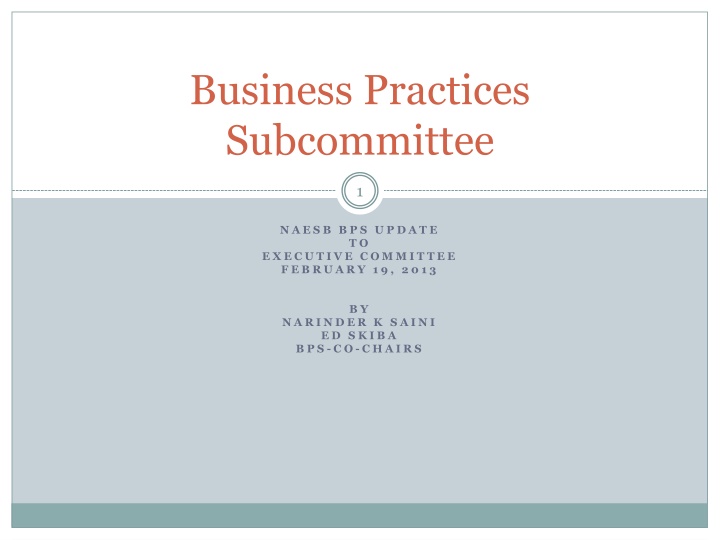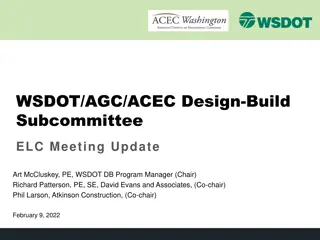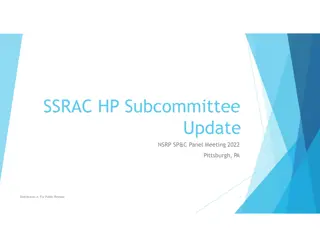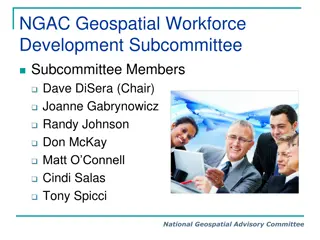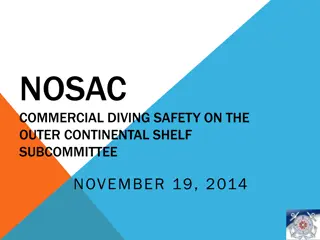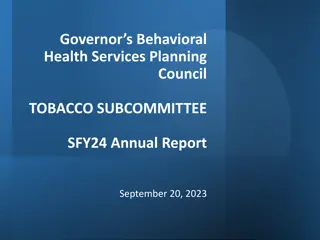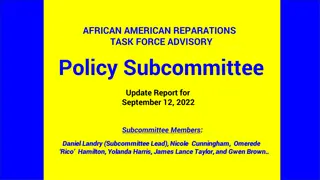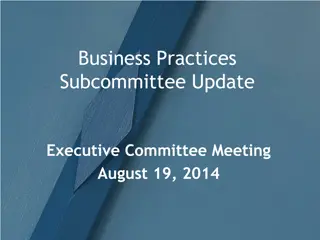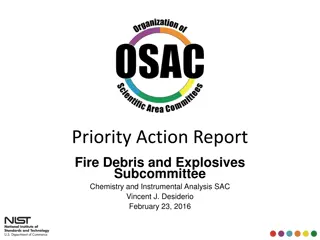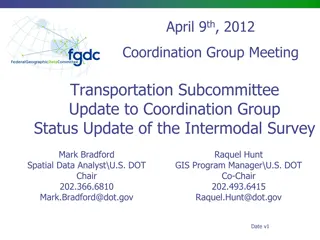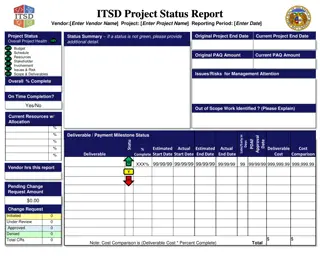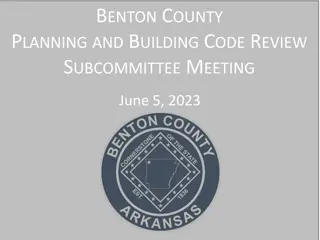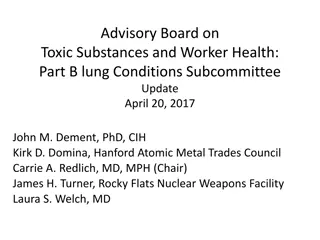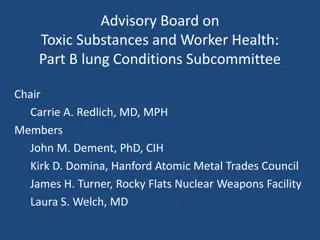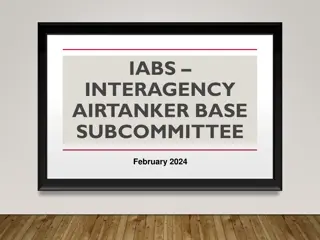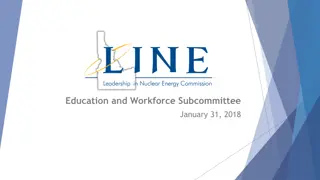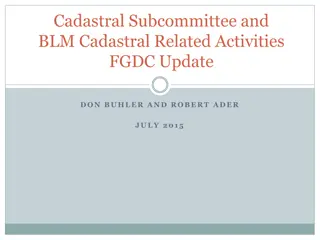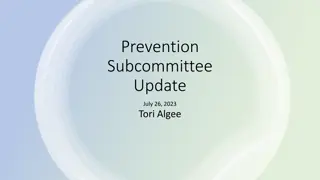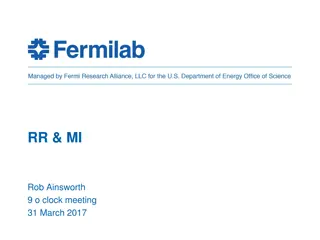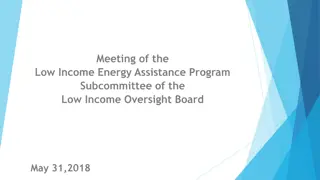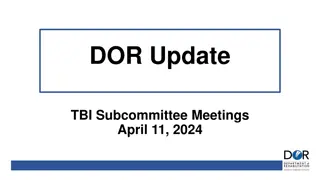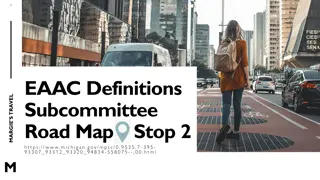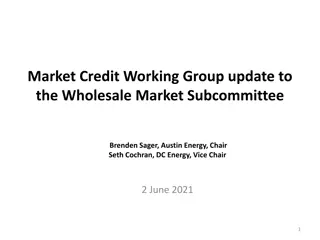Business Practices Subcommittee Update and Status Overview
The Business Practices Subcommittee (BPS) provides an update on its recent activities, including meetings, drafts of standards, and proposed solutions. The subcommittee focuses on Parallel Flow Visualization, Draft Standards, and addressing Annual Plan Items related to transmission loading relief. They aim to enhance reliability coordination and consistency within the Eastern Interconnection. Various recommendations and concerns are discussed to improve business practices.
Uploaded on Sep 16, 2024 | 0 Views
Download Presentation

Please find below an Image/Link to download the presentation.
The content on the website is provided AS IS for your information and personal use only. It may not be sold, licensed, or shared on other websites without obtaining consent from the author.If you encounter any issues during the download, it is possible that the publisher has removed the file from their server.
You are allowed to download the files provided on this website for personal or commercial use, subject to the condition that they are used lawfully. All files are the property of their respective owners.
The content on the website is provided AS IS for your information and personal use only. It may not be sold, licensed, or shared on other websites without obtaining consent from the author.
E N D
Presentation Transcript
Business Practices Subcommittee 1 N A E S B B P S U P D A T E T O E X E C U T I V E C O M M I T T E E F E B R U A R Y 1 9 , 2 0 1 3 B Y N A R I N D E R K S A I N I E D S K I B A B P S - C O - C H A I R S
OVERVIEW 2 Business Practices Subcommittee (BPS) Status Parallel Flow Visualization (PFV) Status Background Objectives NAESB Responsibility IDC Input Proposed Solution Concerns/Dependencies Next Steps
BPS Status 3 Meetings since last report Subcommittee 3 two-day meetings Recommendation Sub-team 5 three-hour conference calls IDC/SDX Users Manuals Sub-team (8) 1-hour conference calls (2) review sessions with IDC Workings Group Results: Draft standards/recommendation Redlined IDC Users Manual and SDX Users Manual NERC Support Document
BPS Status 4 Draft Standards include Changes to the Transmission Loading Relief Process (WEQ-008) Postings on OASIS ATC Information Link (WEQ-001) ScheduleDetail Template (WEQ-002, WEQ-003, WEQ-013) Glossary Updates (WEQ-000 and conforming changes)
BPS Status 5 Draft Standards Address Annual Plan Items: 1.a Parallel Flow Visualization/Mitigation for Reliability Coordinators in the Eastern Interconnection Permanent Solution 1.b Perform consistency review of WEQ-008 Transmission Loading Relief Business Practice Standards and develop recommendation 1.d Revise TLR level 5 to be treated similarly to TLR Level 3 in terms of treating the next hour allocation separately from that of current hour. (R11020)
PFV Background: IRO-006 6 IRO-006 Transmission Loading Relief Each Reliability Coordinator and Balancing Authority that receives a request pursuant to an Interconnection-wide transmission loading relief procedure (such as Eastern Interconnection TLR, WECC Unscheduled Flow Mitigation, or congestion management procedures from the ERCOT Protocols) from any Reliability Coordinator, Balancing Authority, or Transmission Operator in another Interconnection to curtail an Interchange Transaction that crosses an Interconnection boundary shall comply with the request, unless it provides a reliability reason to the requestor why it cannot comply with the request.
PFV Background: Interconnections 7 IRO-006-EAST Transmission Loading Relief Procedures for the Eastern Interconnection WEQ-008 Transmission Loading Relief (TLR) Eastern Interconnection Tools (IDC)Interchange Distribution Calculator (SDX )System Data eXchange IRO-006-WECC Qualified Transfer Path Unscheduled Flow Relief (WECC) IRO-006-TRE IROL & SOL Mitigation in the ERCOT Region
PFV Background: Primary Players 8 NERC Standards Committee Operating Reliability Subcommittee IDC Working Group Standards Drafting Teams NAESB Executive Committee BPS OASIS Subcommittee JESS NAESB NERC IDC SDX Association Association Effective 4/1/2013 IDC - Interchange Distribution Calculator SDX - System Data eXchange
PFV Objectives 9 Generation to load (GTL) impacts reported to the IDC on a real-time basis More accurate assignment of relief obligations to entities causing congestion Near real-time data using generator output provided by RC Include impacts of intra-BA generation-to-load and point-to- point transactions Differentiate between intra-BA firm and non-firm transmission service IDC has better data to perform calculations for TLR Levels 3 and 5
PFV: NAESB RESPONSIBILITY 10 NAESB will establish methodology for assigning the generation to load flows into the appropriate buckets.
PFV: IDC Input 11 Inter-BA Network Interchange Current IDC Inter-BA Point-to-Point Interchange Current IDC Intra-BA Network NAESB Intra-BA Point-to-Point NERC S Ref 10132* Parallel Flow Visualization * http://www.nerc.com/docs/standards/sar/All_Directives_Report_2012-04-05.pdf
PFV Proposed Solution 12 Coordination Arrangements Two-Tier Firm Curtailment Two Methods* Tag Secondary Network Transmission Service, or Generator Prioritization Additional Key Concepts *Assumes that all point-to-point transactions are tagged under NERC standards
PFV Coordination Arrangements 13 Coordination Arrangements Types Coordination Agreements An agreement between two or more Transmission Service Providers for coordination of: a) granting Transmission Service by honoring a set of Flowgate limits and b) managing real-time congestion through congestion management process. Unilateral Declarations allowed if Transmission Service Providers cannot agree Reciprocity A commitment by two Transmission Service Providers to provide Last-to-Curtail treatment of parallel flows on one another s system without having a direct Coordination Agreement. Two-Tier Firm Curtailments encourages Coordination Arrangements
PFV: Two-Tier Firm Curtailment 14 Two-Tier Firm Curtailment First-to-Curtail The Firm Transmission Service curtailment priority assigned by the IDC to parallel flows due to a lack of Coordination Agreement, Reciprocity, or unilateral declaration. Last-to-Curtail The Firm Transmission Service curtailment priority assigned by the IDC to: a) on-path flows and b) parallel flows when a Coordination Agreement, Reciprocity, or unilateral declaration exists between the Transmission Service Provider experiencing congestion and (at least one of) the Transmission Service Provider(s) on the path of the transaction whose Transmission Service is contributing to the congestion.
PFV: First-to Curtail/Last-to-Curtail 15 TSP with Coordination Arrangements Last to Curtail TSPs SOCO X TVA DUK X PJM MISO SPP EES X SOCO TVA DUK PJM MISO SPP EES CONGESTION X X X X X X X X X X X X X X X X X X X X X X Congested TSP: TVA Last to Curtail if tag has TVA, PJM, MISO or SPP on path Congested TSP: PJM Last to Curtail if tag has TVA, DUK, PJM or MISO on path Congested TSP: SPP Last to Curtail if tag has TVA, MISO, SPP or EES on path
PFV: Methods for Intra-BA Transactions 16 Tag Secondary Network Transmission Service Method A method used to submit to the IDC Transmission Service curtailment priority of the Secondary Network Transmission Service using e-Tags. Generator Prioritization Method A method used to submit to the IDC Transmission Service curtailment priority of the generator output. Difference between what is reported and the real- time generator output is firm
PFV Additional Key Concepts 17 Balancing Authority to choose either one but not both Methods Balancing Authority can switch Six month notice LSE (or entity acting on their behalf) enters Tags for Tag Secondary Network Transmission Service Method Generator Priority Schedules for Generator Prioritization Method Transactions or generation-to-load impacting 5% or greater considered for assigning relief obligations
PFV Additional Key Concepts 18 Credit for Redispatch IDC Processing Sub-priorities for TLR Level 5a Reloads of Curtailed Transactions Reallocations for TLR Level 5b Pseudo-Ties (generator physically in one BA but electrically located in another) OASIS ScheduleDetail template modified to identify firm tagged curtailments as First-to-Curtail or Last- to-Curtail.
PFV Concerns/Dependencies 19 NERC INT standards modified to require tagging on all intra-BA Point-to- Point transactions (Project 2008-12) IRO-006-EAST modified to allow a Reliability Coordinator to request curtailments on intra-BAA Point-to-Point tags (Project 2012- 09) IDC Association NAESB/Association coordination Visibility into changes in the IDC Access to data during parallel test/full staffing (NAESB formal request) Parallel Flow Visualization priority
Next Steps 20 Informal Comment Period (February 15 March 15) Recommendation (WEQ-000, 001, 002, 003, 008, 013) IDC User s Manual SDX User s Manual NERC supporting document Industry overview of Parallel Flow Visualization (February 27) Address informal comments (March June) Post for formal comments by end of second quarter
Next Steps 21 Meetings March 20-21 Little Rock, AR (hosted by SPP) April 24-25 Carmel, IN (hosted by MISO) May 22-23 Valley Forge, PA (hosted by PJM) June 19-20 Minneapolis, MN (hosted by OATI)
QUESTIONS 22 ?
